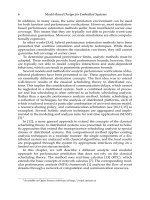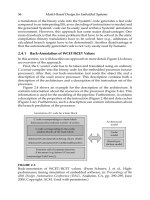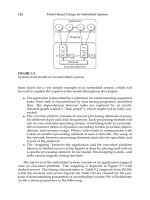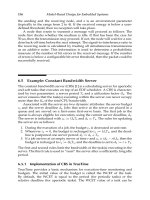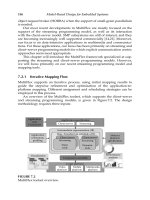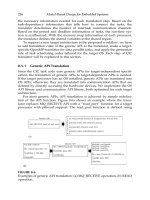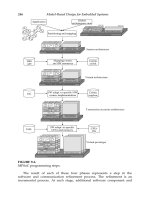Model-Based Design for Embedded Systems- P1 pdf
Bạn đang xem bản rút gọn của tài liệu. Xem và tải ngay bản đầy đủ của tài liệu tại đây (536.38 KB, 30 trang )
Model-Based Design
for Embedded Systems
Computational Analysis, Synthesis,
and Design of Dynamic Models Series
Series Editor
Pieter J. Mosterman
The MathWorks
Natick, Massachusetts
Discrete-Event Modeling and Simulation: A Practitioner's Approach,
Gabriel A. Wainer
Discrete-Event Modeling and Simulation: Theory and Applications,
edited by Gabriel A. Wainer and Pieter J. Mosterman
Model-Based Design for Embedded Systems,
edited by Gabriela Nicolescu and Pieter J. Mosterman
Model-Based Testing for Embedded Systems,
edited by Justyna Zander, Ina Schieferdecker, and Pieter J. Mosterman
Multi-Agent Systems: Simulation & Applications,
edited by Adelinde M. Uhrmacher and Danny Weyns
Model-Based Design
for Embedded Systems
Gabriela Nicolescu
Pieter J. Mosterman
Boca Raton London New York
CRC Press is an imprint of the
Taylor & Francis Group, an informa business
MATLAB® and Simulink® are trademarks of The MathWorks, Inc. and are used with permission. The MathWorks does not warrant the accuracy of the text of exercises in this book. This book’s use or discussion
of MATLAB® and Simulink® software or related products does not constitute endorsement or sponsorship
by The MathWorks of a particular pedagogical approach or particular use of the MATLAB® and Simulink®
software.
CRC Press
Taylor & Francis Group
6000 Broken Sound Parkway NW, Suite 300
Boca Raton, FL 33487-2742
© 2010 by Taylor and Francis Group, LLC
CRC Press is an imprint of Taylor & Francis Group, an Informa business
No claim to original U.S. Government works
Printed in the United States of America on acid-free paper
10 9 8 7 6 5 4 3 2 1
International Standard Book Number: 978-1-4200-6784-2 (Hardback)
This book contains information obtained from authentic and highly regarded sources. Reasonable efforts
have been made to publish reliable data and information, but the author and publisher cannot assume
responsibility for the validity of all materials or the consequences of their use. The authors and publishers
have attempted to trace the copyright holders of all material reproduced in this publication and apologize to
copyright holders if permission to publish in this form has not been obtained. If any copyright material has
not been acknowledged please write and let us know so we may rectify in any future reprint.
Except as permitted under U.S. Copyright Law, no part of this book may be reprinted, reproduced, transmitted, or utilized in any form by any electronic, mechanical, or other means, now known or hereafter invented,
including photocopying, microfilming, and recording, or in any information storage or retrieval system,
without written permission from the publishers.
For permission to photocopy or use material electronically from this work, please access www.copyright.
com ( or contact the Copyright Clearance Center, Inc. (CCC), 222 Rosewood
Drive, Danvers, MA 01923, 978-750-8400. CCC is a not-for-profit organization that provides licenses and
registration for a variety of users. For organizations that have been granted a photocopy license by the CCC,
a separate system of payment has been arranged.
Trademark Notice: Product or corporate names may be trademarks or registered trademarks, and are used
only for identification and explanation without intent to infringe.
Library of Congress Cataloging-in-Publication Data
Model-based design for embedded systems / Gabriela Nicolescu, Pieter J. Mosterman.
p. cm. -- (Computational analysis, synthesis, and design of dynamic models series)
Includes bibliographical references and index.
ISBN 978-1-4200-6784-2 (hardcover : alk. paper)
1. Embedded computer systems--Design and construction. I. Nicolescu, G. (Gabriela)
II. Mosterman, Pieter J. III. Title. IV. Series.
TK7895.E42M62 2010
004.16--dc22
Visit the Taylor & Francis Web site at
and the CRC Press Web site at
2009036996
Contents
Preface . . . . . . . . . . . . . . . . . . . . . . . . . . . . . . . . . . . . .
ix
Introduction . . . . . . . . . . . . . . . . . . . . . . . . . . . . . . . . . .
xi
Contributors . . . . . . . . . . . . . . . . . . . . . . . . . . . . . . . . . .
xix
Part I Real-Time and Performance Analysis in
Heterogeneous Embedded Systems
1 Performance Prediction of Distributed Platforms . . . . . . . . . .
Lothar Thiele and Simon Perathoner
2 SystemC-Based Performance Analysis of Embedded
Systems . . . . . . . . . . . . . . . . . . . . . . . . . . . . . . . . . .
Jürgen Schnerr, Oliver Bringmann, Matthias Krause,
Alexander Viehl, and Wolfgang Rosentiel
3 Formal Performance Analysis for Real-Time Heterogeneous
Embedded Systems . . . . . . . . . . . . . . . . . . . . . . . . . . . .
Simon Schliecker, Jonas Rox, Rafik Henia, Razvan Racu,
Arne Hamann, and Rolf Ernst
4 Model-Based Framework for Schedulability Analysis
Using UPPAAL 4.1 . . . . . . . . . . . . . . . . . . . . . . . . . . . . .
Alexandre David, Jacob Illum, Kim G. Larsen, and Arne Skou
3
27
57
93
5 Modeling and Analysis Framework for Embedded
Systems . . . . . . . . . . . . . . . . . . . . . . . . . . . . . . . . . . 121
Jan Madsen, Michael R. Hansen, and Aske W. Brekling
6 TrueTime: Simulation Tool for Performance Analysis
of Real-Time Embedded Systems . . . . . . . . . . . . . . . . . . . 145
Anton Cervin and Karl-Erik Årzén
v
vi
Contents
Part II Design Tools and Methodology for
Multiprocessor System-on-Chip
7 MPSoC Platform Mapping Tools for Data-Dominated
Applications . . . . . . . . . . . . . . . . . . . . . . . . . . . . . . . . 179
Pierre G. Paulin, Olivier Benny, Michel Langevin, Youcef Bouchebaba,
Chuck Pilkington, Bruno Lavigueur, David Lo, Vincent Gagne,
and Michel Metzger
8 Retargetable, Embedded Software Design Methodology
for Multiprocessor-Embedded Systems . . . . . . . . . . . . . . . . 207
Soonhoi Ha
9 Programming Models for MPSoC . . . . . . . . . . . . . . . . . . . 231
Katalin Popovici and Ahmed Jerraya
10 Platform-Based Design and Frameworks:
METROPOLIS and METRO II . . . . . . . . . . . . . . . . . . . . . . . 259
Felice Balarin, Massimiliano D’Angelo, Abhijit Davare, Douglas Densmore,
Trevor Meyerowitz, Roberto Passerone, Alessandro Pinto, Alberto
Sangiovanni-Vincentelli, Alena Simalatsar, Yosinori Watanabe,
Guang Yang, and Qi Zhu
11 Reconfigurable Multicore Architectures for Streaming
Applications . . . . . . . . . . . . . . . . . . . . . . . . . . . . . . . . 323
Gerard J. M. Smit, André B. J. Kokkeler, Gerard K. Rauwerda,
and Jan W. M. Jacobs
12 FPGA Platforms for Embedded Systems . . . . . . . . . . . . . . . 351
Stephen Neuendorffer
Part III Design Tools and Methodology for
Multidomain Embedded Systems
13 Modeling, Verification, and Testing Using Timed and
Hybrid Automata . . . . . . . . . . . . . . . . . . . . . . . . . . . . . 383
Stavros Tripakis and Thao Dang
14 Semantics of Domain-Specific Modeling Languages . . . . . . . . 437
Ethan Jackson, Ryan Thibodeaux, Joseph Porter,
and Janos Sztipanovits
15 Multi-Viewpoint State Machines for Rich
Component Models . . . . . . . . . . . . . . . . . . . . . . . . . . . 487
Albert Benveniste, Bent Caillaud, and Roberto Passerone
Contents
vii
16 Generic Methodology for the Design of Continuous/Discrete
Co-Simulation Tools . . . . . . . . . . . . . . . . . . . . . . . . . . . 519
Luiza Gheorghe, Gabriela Nicolescu, and Hanifa Boucheneb
17 Modeling and Simulation of Mixed Continuous and
Discrete Systems . . . . . . . . . . . . . . . . . . . . . . . . . . . . . 559
Edward A. Lee and Haiyang Zheng
18 Design Refinement of Embedded Mixed-Signal Systems . . . . . 585
Jan Haase, Markus Damm, and Christoph Grimm
19 Platform for Model-Based Design of Integrated
Multi-Technology Systems . . . . . . . . . . . . . . . . . . . . . . . 603
Ian O’Connor
20 CAD Tools for Multi-Domain Systems on Chips . . . . . . . . . . 643
Steven P. Levitan, Donald M. Chiarulli, Timothy P. Kurzweg,
Jose A. Martinez, Samuel J. Dickerson, Michael M. Bails,
David K. Reed, and Jason M. Boles
21 Smart Sensors Modeling Using VHDL-AMS for
Microinstrument Implementation with a Distributed
Architecture . . . . . . . . . . . . . . . . . . . . . . . . . . . . . . . . 697
Carles Ferrer, Laura Barrachina-Saralegui, and Bibiana Lorente-Alvarez
Index . . . . . . . . . . . . . . . . . . . . . . . . . . . . . . . . . . . . . . 719
Preface
The unparalleled flexibility of computation has been a key driver and feature bonanza in the development of a wide range of products across a broad
and diverse spectrum of applications such as in the automotive aerospace,
health care, consumer electronics, etc. Consequently, the embedded microprocessors that implement computational functionality have become a part
of almost every facet of our world, thereby significantly improving the quality of our lives. The versatility of computational features invites and endorses
a degree of imagination and creativity in design that has unlocked an almost
insatiable demand for consistently increasing both the complexity of embedded systems and the performance of embedded computations. The quest to
rise to these demands has resulted in computing architectures of a heterogeneous nature. These architectures often integrate several types of processors,
analog and digital electronic components, as well as mechanical and optical
components, all on a single chip. To efficiently design for such heterogeneity and to maximally exploit its capabilities have become one of the most
prominent challenges that we are now faced with as a design automation
community.
Model-Based Design is emerging as a solution to bridge the gap between
computational capabilities that are available but that we are yet unable to
exploit. Using a computational approach in the design itself allows raising the level of abstraction of the system specification at which novel and
differentiating functionalities are captured. Automation can then assist in
refining this specification to an implementation. For this to be successful, performance studies of potential implementations at a high level of abstraction
are essential, combined with the necessity of traceability and parameterization throughout the refinement process.
This book provides a compilation of the work of internationally
renowned authors on Model-Based Design. Each chapter contributes
supreme results that have helped establish Model-Based Design and that
continue to expand its barriers. The respective authors excel in their expertise on the automation of design refinement and how to relate properties
throughout this refinement while enabling analytic and synthetic qualities.
We are delighted and honored by their participation in the effort that led to
this book, and we sincerely hope that the readers will find the indulgence of
intellectual achievement as enjoyable and stimulating as we do.
In closing, we would like to express our genuine appreciation and gratitude for all the time and effort that each of the authors has put in. Our
ix
x
Preface
pleasant collaboration has certainly helped make the completion of this
project as easy as possible. Of course, none of this would have been possible
without the continuous support of the team at Taylor & Francis, especially
our publisher, Nora Konopka, and the staff involved in the verification and
production process: Amy Blalock, Ashley Gasque, and Catherine Giacari.
Many thanks to each of you. A special word of thanks goes out to Jeanne
Daunais for helping us with the extensive preparation of the final material.
Gabriela Nicolescu
Pieter J. Mosterman
MATLAB R is a registered trademark of The MathWorks, Inc. For product
information, please contact:
The MathWorks, Inc.
3 Apple Hill Drive
Natick, MA 01760-2098 USA
Tel: 508 647 7000
Fax: 508-647-7001
E-mail:
Web: www.mathworks.com
See www.mathworks.com/trademarks< />for a list of additional trademarks.
Introduction
Gabriela Nicolescu and Pieter J. Mosterman
The purpose of this book is to provide a comprehensive overview of the
current state of Model-Based Design for embedded systems, the challenges
involved, and the latest trends. To achieve this objective, the book offers a
compilation of 21 outstanding contributions from industry and academia.
The contributions are grouped into three main parts. Part I comprises the
contributions that focus on a key dimension in the design of embedded systems: the performance analysis of real-time behavior based on computational
models. Part II is composed of contributions proposing approaches that take
into consideration the specific characteristics and design challenges of multiprocessor systems-on-chip (MPSoCs). Part III contains contributions in the
field of system-level design of multidomain systems.
An “embedded system” is a system designed to perform a dedicated
function, typically with tight real-time constraints, limited dimensions, and
low cost and low-power requirements. It is a combination of computer hardware and software and additional mechanical, optical, or other parts that
are typically used in the specific role of actuators, sensors, and transducers, in general. In some cases, embedded systems are part of a larger system or product, for example, an antilock braking system in a car. Examples
of embedded systems are cell phones, digital cameras, GPS receivers, fax
machines, printers, debit/credit card readers, heart rate monitors, blood gas
monitors, etc. [Gan03].
The evolution of embedded systems parallels Moore’s law, which states
that the number of transistors on an integrated circuit doubles every 18
months. This technological progress enabled the integration of complex electronic systems on a single chip and the emergence of MPSoCs. An MPSoC is
a system-on-chip that contains multiple interconnected instruction-set processors (CPUs). The typical MPSoC is a heterogeneous multiprocessor [Jer04]:
it is composed of several different types of processing elements. Moreover,
the memory architecture and the interconnection network may be heterogeneous as well. MPSoCs can be found in many products such as digital televisions, set-top boxes, telecommunication networks, cell phones, and video
games.
In response to the challenges of further miniaturization, the International Technology Roadmap for Semiconductors (ITRS) emphasizes the
More Than Moore’s Law movement [ITR07]. This movement focuses on
xi
xii
Introduction
system integration rather than an increase in transistor density and leads
to a functional diversification in integrated systems. This diversification
allows for nondigital functionality such as radio-frequency (RF) circuitry;
power control, optical, and/or mechanical components; sensors; and actuators to migrate from the system board level into the so-called system-inpackage (SiP) level or system-on-chip (SoC) level implementation [TUM06].
These multidomain heterogeneous systems enable new applications and create
new markets. System applications are in key fields such as transportation,
mobility, security, health, energy, communication, education, and entertainment [ZHA06]. Some examples of applications of these systems are devices
for nonintrusive surgery, sensors for harsh environments (e.g., chemically
aggressive, extreme temperature, excessive vibration, and high shock), car
surround sensors, precrash detection, energy autonomous systems, tire pressure monitoring, car-to-car communication and navigation, and ultrasonic
devices (e.g., for distance measurement and three-dimensional imaging).
The heterogeneity of modern embedded systems is responsible for a
complexity that is exceptionally challenging to their design. Moreover,
these systems have particularly tight performance, time-to-market, and cost
constraints. To meet these constraints, engineers must find solutions to
efficiently design systems including complex electronic components that
integrate several cores, RF circuitry, digital and analog hardware components, as well as mechanical and optical components. Model-Based Design
addresses this issue by focusing on computational models as the core design
artifact. The model enables a hierarchical design process where the entire
system is first represented at an abstract level while model elaboration iteratively refines this design and includes details as necessary to implement the
required functionality. Thus, different models that may be playing different
roles are required for the main stages of the design: the specification, the
test and validation, and the consecutive refinement. The ability to efficiently
construct models combined with associated tools and systematic methodologies primes Model-Based Design for success by providing a complete solution that enables concurrent engineering, performance analysis, automatic
test generation, building efficient specifications and execution models, code
generation and optimization, and automatic refinement through different
abstraction levels.
This book provides a comprehensive survey and overview of the benefits
of Model-Based Design in the field of heterogeneous embedded systems. The
selected contributions present successful approaches where models, tools,
and methodologies result in important cost reduction and performance gain
of heterogeneous embedded systems while decreasing their time-to-market.
Organization
This book is divided into three parts: Part I—Real-Time and Performance
Analysis in Heterogeneous Embedded Systems, Part II—Design Tools and
Methodology for Multiprocessor System-on-Chip, and Part III—Design
Introduction
xiii
Tools and Methodology for Multidomain Embedded Systems. The following
text presents an overview of each of the parts along with a brief introduction
to the contents of each of the chapters.
Part I. Real-Time and Performance Analysis in Heterogeneous
Embedded Systems
Part I highlights the importance of considering the real-time aspects of heterogeneous embedded systems along with analyses of their performance.
This part comprises six chapters that focus on capturing the aspects of timing in models for embedded systems, and on defining tools that exploit these
models in order to provide accurate performance prediction and analysis in
the early stages of design. These aspects are illustrated by means of applications in the fields of signal and image processing, automotive, robotics, and
wireless communications.
Chapter 1 provides a clear introduction to system-level performance prediction and analysis. It highlights its role in design and provides an overview
of the two main approaches currently employed in this field: the analytical
and the simulation-based approaches. The introduction to the performance
prediction and analysis stage is realized by means of a concrete videoprocessing application scenario. Finally, this chapter describes a modular
framework that enables the analysis of the flow of event streams through
a network of computation and communication resources.
Chapter 2 discusses a hybrid approach that resolves performance analysis issues by combining the advantages of simulation-based and analytical
approaches. A methodology is presented based on a cycle-accurate simulation approach for embedded software that also allows the integration
of abstract SystemC models. The methodology is illustrated by an audioprocessing application.
Chapter 3 provides a comprehensive overview of a generic and modular
framework for formal performance analysis. After an introduction to hierarchical communications and MPSoC architectures and their implications on
performance, this chapter presents a methodology to systematically investigate the sensitivity of a given system configuration and to explore the design
space for optimal configurations. Finally, this chapter illustrates the timing bottlenecks in an illustrative heterogeneous automotive architecture, and
shows how to improve the performance guided by sensitivity analysis and
system exploration.
Chapter 4 proposes a modeling framework that may be instantiated to
suit a variety of scheduling scenarios and can be easily extended. This chapter first introduces the formalism underlying the approach by means of an
example. The framework that is used and the types of schedulability problems that can be analyzed using this framework are then presented. The
framework is then applied to the analysis of an example system.
Chapter 5 presents the MOVeS analysis framework that can be used
to provide schedulability analyses for multicore embedded systems. This
framework is based on an embedded system model that consists of an
xiv
Introduction
application model, an execution platform model, and a system model, which
is a particular mapping of the application onto the execution platform. The
model is represented using timed automata. Finally, this chapter shows how
the framework can be used to verify properties of an embedded system by
means of a number of examples including that of a smart phone, showing
the ability to handle systems of realistic size.
Chapter 6 introduces a MATLAB R /Simulink R -based simulation approach. It provides models of multitasking real-time kernels and networks that
can be used in simulation models for network-embedded control systems.
The application of this tool is illustrated by means of a simulation of mobile
robots in a sensor network.
Part II. Design Tools and Methodology for Multiprocessor
System-on-Chip
Part II addresses the Model-Based Design of MPSoCs. This part provides
a comprehensive overview of current design practices, the MPSoC systems
applications, as well as the theory behind the current and future tools and
methodologies for MPSoC design. It consists of six chapters presenting
solutions for the main challenges of MPSoC design. Tools and methodologies are proposed for modeling and programming complex applications for
MPSoCs, mapping these applications manually and/or automatically onto
parallel MPSoC platforms; defining programming models for abstracting the
hardware/software interfaces; and exploiting novel, efficient platforms and
developing unified methodologies for MPSoC platform-based designs. To
introduce these concepts and to illustrate the efficiency of the proposed solutions, the chapters illustrate several case studies in the fields of multimedia,
wireless communications, telecommunications, and control.
Chapter 7 starts with an overview of the market trends and the key role
played by MPSoC systems in contemporary industrial practice. It introduces
the programming models used for MPSoCs and the main characteristics of
the MPSoC platforms. This chapter also presents the MultiFlex technology
that supports the mapping of user-defined parallel applications, expressed
in one or more programming models, onto an MPSoC platform. Finally, this
chapter illustrates the application of the proposed technology to the design
of a wireless system, a 3G WCDMA/FDD base-station.
Chapter 8 presents a novel methodology for embedded software design
based on a parallel programming model, called common intermediate code
(CIC). In a CIC, the function and data parallelisms of application tasks are
specified independently of the target architecture and design constraints.
Information on the target architecture and the design constraints is separately described in an architecture information file. Based on this information, the programmer maps tasks to processing components, either manually
or automatically. The efficiency of the proposed methodology is illustrated
using a multimedia application, the H.263 decoder.
Introduction
xv
Chapter 9 presents a definition of the programming models that abstract
hardware/software interfaces in the case of heterogeneous MPSoCs. Then,
a programming environment is proposed that identifies several programming models at different MPSoC abstraction levels. The proposed approach
combines the Simulink environment for high-level programming and the
SystemC design language for low-level programming. The proposed
methodology is applied to a heterogeneous multiprocessor platform, to
explore the communication architecture and to generate efficient executable
code of the software stack for an H.264 video encoder application.
Chapter 10 discusses design principles and how a unified methodology together with a supporting software framework can be developed to
improve the level of efficiency of the embedded electronics industry. This
chapter first presents the design challenges for future systems and a manifesto espousing the benefits of a unified methodology. Then a methodology, a platform-based design, is summarized. The chapter proceeds to
present Metropolis, a software framework supporting the methodology, and
Metro II, a second-generation framework tailored to industrial test cases. It
concludes with two test cases in diverse domains: semiconductor chips (a
universal mobile telecommunication system multichip design) and energyefficient buildings (an indoor air quality control system).
Chapter 11 presents reconfigurable heterogeneous and homogeneous
multicore SoC platforms for streaming digital signal–processing (DSP) applications. Typical examples of streaming DSP applications are wireless baseband processing, multimedia processing, medical image processing, sensor
processing (e.g., for remote surveillance cameras), and phased-array radars.
This chapter first introduces streaming applications and multicore architectures, presents key design criteria for streaming applications, and concludes
with a multidimensional classification of architectures for streaming applications. For each category, one or more sample architectures are presented.
Chapter 12 describes the use of partial reconfiguration capabilities of
some field programmable gate array (FPGAs) to provide a platform that is
similar to existing general-purpose FPGAs. Partial reconfiguration involves
the reconfiguration of part of an FPGA (a reconfigurable region) while
another part of the FPGA (a static region) remains active and operating. This
chapter illustrates this approach by presenting a case study on the design of
a software-defined radio platform.
Part III. Design Tools and Methodology for Multidomain Embedded
Systems
Part III covers Model-Based Design for multidomain systems. Continuoustime and discrete-event models are at the core of Model-Based Design for
these systems. This part of the book is composed of nine chapters and
addresses the following challenges: validating and testing traditional formal models used for blending the continuous and discrete worlds, defining
semantics for combining models specific to different domains, defining and
xvi
Introduction
exploiting new languages that embrace the heterogeneity of domains, unambiguous specification of semantics for domain-specific modeling languages
(DSMLs), and developing new methodologies for Model-Based Design for
that are able to take into account the heterogeneity in multidomain systems.
Model-Based Design for illustrative heterogeneous systems such as optoelectromechanical and mixed-signal systems are discussed in detail.
Chapter 13 provides a comprehensive overview of modeling with timed
and hybrid automata. These types of automata have been introduced in order
to blend the discrete world of computers with the continuous physical world.
This chapter presents the basics of timed and hybrid automata models and
methods for exhaustive or partial verification, as well as testing for these
models.
Chapter 14 captures the fundamental problems, methods, and techniques
for specifying the semantics of DSMLs. The effective application of DSMLs
for an embedded design requires developers to have an unambiguous specification of the semantics of modeling languages. This chapter explores two
key aspects of this problem: the specifications of structural and behavioral
semantics.
Chapter 15 emphasizes combining different modeling perspectives and
provides a simple and elegant notion of parallel composition. This chapter
first reviews the concepts of “component” and “contract” from a semantic
point of view. Then, the extended state machine model is described. The syntax and the expressive power used for expressions in the transitions of the
state-based model are reviewed, followed by the specialization of the model
into different categories to support alternative perspectives.
Chapter 16 presents an approach to solve the problem of combining
continuous-time and discrete-event execution models. This chapter focuses
on the analysis of the two execution models and on the definition of models for simulation interfaces required for combining these models in a global
continuous/discrete execution model. It proposes a generic methodology,
independent of the simulation language, for the design of continuous/
discrete cosimulation tools.
Chapter 17 provides an operational semantics that supports a combination of synchronous/reactive (SR) systems, discrete-event (DE) systems, and
continuous-time (CT) dynamics. This chapter outlines a corresponding denotational semantics. Dialects of DE and CT are developed that generalize SR
but provide complementary modeling and design capabilities.
Chapter 18 provides an overview of the analog, mixed signal (AMS)
extensions for SystemC. With these extensions, SystemC becomes amenable
to modeling HW/SW systems and—at the function and architecture levels—
analog and mixed-signal subsystems. The intended uses include executable
specification, architecture exploration, virtual prototyping, and integration
validation. This chapter describes a methodology that efficiently exploits the
AMS extensions together with newly introduced converter channels. The
methodology is illustrated by applying it to a software-defined radio system.
Introduction
xvii
Chapter 19 presents several aspects of heterogeneous design methods
in the context of increasing diversification of integration technologies. This
chapter first provides the rationale and analysis of the multitechnology need
in terms of technological evolution and highlights the need for advances
in this domain. It then presents RuneII , a platform that addresses some
of these needs. Finally, it illustrates the direct application of the proposed
approach for optical link synthesis and technology performance characterization by analyzing optical link performance for two sets of photonic component parameters and three CMOS technology generations.
Chapter 20 concentrates on multidomain modeling and multirate simulation tools that are required to support mixed-technology system-level design.
This chapter proposes the Chatoyant environment for simulating and analyzing optical microelectromechanical systems (MEMSs). By supporting a
variety of multidomain components and signal modeling techniques at multiple levels of abstraction, Chatoyant has the ability to perform and analyze mixed-signal trade-offs, which makes it invaluable to multitechnology
system designers.
Chapter 21 underscores the importance of the role of behavioral modeling in the design of multidomain systems. This chapter presents a case study
where mixed-signal hardware description languages are used to specify and
simulate systems composed of elements of a different nature. A VHDLAMS-based approach is applied for the behavioral modeling of MEMS-based
microinstrumentation.
References
[Gan03] J. Gannsle and M. Barr, Embedded Systems Dictionary, CMP Books,
San Francisco, CA, 2003.
[ITR07]
International Technology Roadmap for Semiconductors, ITRS 2007
Rapport.
[Jer04]
A. Jerraya and W. Wolf, Multiprocessors Systems-on-Chip, Morgan
Kaufmann, San Francisco, CA, 2004.
[TUM06] R. Tummala, Moore’s law meets its match, IEEE Spectrum, 43(6),
44–49, June 2006 Issue.
[ZHA06] G. Q. Zhang, M. Graef, and F. van Roosmalen, Strategic research
agenda of “More than Moore,” in Proceedings of EuroSime 2006,
Como, Italy, pp. 1–6, April 24–26, 2006.
Contributors
Karl-Erik Årzén
Department of Automatic Control
Lund Institute of Technology
Lund University
Lund, Sweden
Michael M. Bails
FedEx Ground
Pittsburgh, Pennsylvania
Felice Balarin
Cadence Berkeley Labs
Berkeley, California
Laura Barrachina-Saralegui
Institut de Microelectrònica de
Barcelona
Centre Nacional de Microelectrònica
Barcelona, Spain
Olivier Benny
STMicroelectronics, Inc.
Ottawa, Ontario, Canada
Albert Benveniste
Institut de Recherche en
Informatique et Systèmes
Aléatoires
Institut National de Recherche
en Informatique et en
Automatique
Rennes, France
Jason M. Boles
Department of Computational
Biology
University of Pittsburgh
Pittsburgh, Pennsylvania
Youcef Bouchebaba
STMicroelectronics, Inc.
Ottawa, Ontario, Canada
Hanifa Boucheneb
Department of Computer and
Software Engineering
Ecole Polytechnique de Montreal
Montreal, Quebec, Canada
Aske W. Brekling
Department of Informatics and
Mathematical Modelling
Technical University of Denmark
Lyngby, Denmark
Oliver Bringmann
Forschungszentrum Informatik
Karlsruhe, Germany
Bent Caillaud
Institut de Recherche en
Informatique et Systèmes
Aléatoires
Institut National de Recherche
en Informatique et en
Automatique
Rennes, France
Anton Cervin
Department of Automatic Control
Lund Institute of Technology
Lund University
Lund, Sweden
xix
xx
Contributors
Donald M. Chiarulli
Department of Computer Science
University of Pittsburgh
Pittsburgh, Pennsylvania
Massimiliano D’Angelo
PARADES GEIE
Rome, Italy
Markus Damm
Institute of Computer Technology
Vienna University of Technology
Vienna, Austria
Thao Dang
Verimag Laboratory
Centre National de la Recherche
Scientifique
Grenoble, France
Abhijit Davare
Intel Corporation
Santa Clara, California
Alexandre David
Department of Computer Science
Center for Embedded Software
Systems
Aalborg University
Aalborg, Denmark
Douglas Densmore
Department of Electrical
Engineering and Computer Science
University of California at Berkeley
Berkeley, California
Samuel J. Dickerson
Department of Electrical and
Computer Engineering
University of Pittsburgh
Pittsburgh, Pennsylvania
Rolf Ernst
Institute of Computer and
Network Engineering
Technische Universität
Braunschweig
Braunschweig, Germany
Carles Ferrer
Instituto de Microelectrònica de
Barcelona
Centro Nacional de Microelectrónica
Universitat Autonịma de Barcelona
Barcelona, Spain
and
Department de Microelectrịnica i
Sistemes Electrònics
Universitat Autonòma de Barcelona
Barcelona, Spain
Vincent Gagne
STMicroelectronics, Inc.
Ottawa, Ontario, Canada
Luiza Gheorghe
Department of Computer and
Software Engineering
Ecole polytechnique de Montreal
Montreal, Quebec, Canada
Christoph Grimm
Institute of Computer Technology
Vienna University of Technology
Vienna, Austria
Soonhoi Ha
School of Computer Science and
Engineering
Seoul National University
Seoul, Republic of Korea
Jan Haase
Institute of Computer Technology
Vienna University of Technology
Vienna, Austria
Contributors
Arne Hamann
Institute of Computer and
Network Engineering
Technische Universität
Braunschweig
Braunschweig, Germany
Michael R. Hansen
Department of Informatics and
Mathematical Modelling
Technical University of Denmark
Lyngby, Denmark
Rafik Henia
Institute of Computer and
Network Engineering
Technische Universität
Braunschweig
Braunschweig, Germany
Jacob Illum
Department of Computer Science
Center for Embedded Software
Systems
Aalborg University
Aalborg, Denmark
Ethan Jackson
Microsoft Research
Redmond, Washington
Jan W. M. Jacobs
OCE Technologies
Venlo, the Netherlands
Ahmed Jerraya
Atomic Energy Commission
Laboratory of the Electronics and
Information Technology
MINATEC
Grenoble, France
xxi
André B. J. Kokkeler
Department of Electrical
Engineering, Mathematics and
Computer Science
University of Twente
Enschede, the Netherlands
Matthias Krause
Forschungszentrum Informatik
Karlsruhe, Germany
Timothy P. Kurzweg
Department of Electrical and
Computer Engineering
Drexel University
Philadelphia, Pennsylvania
Michel Langevin
STMicroelectronics, Inc.
Ottawa, Ontario, Canada
Kim G. Larsen
Department of Computer Science
Center for Embedded Software
Systems
Aalborg University
Aalborg, Denmark
Bruno Lavigueur
STMicroelectronics, Inc.
Ottawa, Ontario, Canada
Edward A. Lee
University of California at Berkeley
Berkeley, California
Steven P. Levitan
Department of Electrical and
Computer Engineering
University of Pittsburgh
Pittsburgh, Pennsylvania
David Lo
STMicroelectronics, Inc.
Ottawa, Ontario, Canada
xxii
Contributors
Bibiana Lorente-Alvarez
Department de Microelectrònica
Universitat Autonòma de Barcelona
Barcelona, Spain
Pierre G. Paulin
STMicroelectronics, Inc.
Ottawa, Ontario, Canada
Jan Madsen
Department of Informatics and
Mathematical Modelling
Technical University of Denmark
Lyngby, Denmark
Simon Perathoner
Computer Engineering and
Networks Laboratory
Swiss Federal Institute of
Technology Zurich
Zurich, Switzerland
Jose A. Martinez
Cadence Design Systems, Inc.
San Jose, California
Michel Metzger
STMicroelectronics, Inc.
Ottawa, Ontario, Canada
Trevor Meyerowitz
Sun Microsystems
Menlo Park, California
Stephen Neuendorffer
Xilinx Research Labs
San Jose, California
Gabriela Nicolescu
Department of Computer and
Software Engineering
Ecole Polytechnique de Montreal
Montreal, Quebec, Canada
Ian O’Connor
Lyon Institute of Nanotechnology
Ecole Centrale de Lyon
University of Lyon
Ecully, France
Roberto Passerone
Dipartimento di Ingegneia e
Scienza dell’ Informazione
University of Trento
Trento, Italy
Chuck Pilkington
STMicroelectronics, Inc.
Ottawa, Ontario, Canada
Alessandro Pinto
United Technology Research
Center
Berkeley, California
Katalin Popovici
TIMA Laboratory
Grenoble, France
and
The MathWorks, Inc.
Natick, Massachusetts
Joseph Porter
Institute for Software Integrated
Systems
Vanderbilt University
Nashville, Tennessee
Razvan Racu
Institute of Computer and
Network Engineering
Technische Universität
Braunschweig
Braunschweig, Germany
and
PARADES S.c.a.r.l.
Rome, Italy
Gerard K. Rauwerda
Recore Systems
Enschede, the Netherlands
Contributors
David K. Reed
Keynote Systems
San Mateo, California
Wolfgang Rosenstiel
Forschungszentrum Informatik
Karlsruhe, Germany
Jonas Rox
Institute of Computer and
Network Engineering
Technische Universität
Braunschweig
Braunschweig, Germany
Arne Skou
Department of Computer Science
Center for Embedded Software
Systems
Aalborg University
Aalborg, Denmark
Gerard J. M. Smit
Department of Electrical
Engineering, Mathematics &
Computer Science
University of Twente
Enschede, the Netherlands
Alberto Sangiovanni-Vincentelli
Department of Electrical
Engineering
and Computer Science
University of California at Berkeley
Berkeley, California
Janos Sztipanovits
Institute for Software Integrated
Systems
Vanderbilt University
Nashville, Tennessee
and
Ryan Thibodeaux
South West Research Institute
San Antonio, Texas
Advanced Laboratory on Embedded
Systems
Roma, Italy
Simon Schliecker
Institute of Computer and
Network Engineering
Technische Universität
Braunschweig
Braunschweig, Germany
Jürgen Schnerr
Forschungszentrum Informatik
Karlsruhe, Germany
Alena Simalatsar
Dipartimento di Ingegneria e
Scienza dell’ Informazione
University of Trento
Trento, Italy
xxiii
Lothar Thiele
Computer Engineering and
Networks Laboratory
Swiss Federal Institute of
Technology Zurich
Zurich, Switzerland
Stavros Tripakis
Verimag Laboratory
Centre National de la Recherche
Scientifique
Grenoble, France
Alexander Viehl
Forschungszentrum Informatik
Karlsruhe, Germany
xxiv
Yosinori Watanabe
Cadence Design Systems, Inc.
San Jose, California
Guang Yang
National Instruments
Corporation
Austin, Texas
Contributors
Haiyang Zheng
University of California at
Berkeley
Berkeley, California
Qi Zhu
Intel Corporation
Santa Clara, California

